Free the mind from Photoshop - a fresh concept of image processing
I love Photoshop. Honestly! I have been working with him every day for ten years. One cannot overestimate the influence of Photoshop on the digital graphics industry - which largely determines how the world around us looks! I'm pretty sure that right now in your room there is at least one thing that Photoshop has been involved in in the design. And, of course, the pictures for this article were prepared in Photoshop!
Photoshop is the leader in its field. It can be called "standard" (which is rather good) or "monopolist" (which is rather bad). But the fact remains that if you work with any kind of digital graphics, you have to think in terms of Photoshop and follow the ideas of its creators.
Frankly, Photoshop is not the most complex computer program of the existing ones (since, frankly, digital images are not the most difficult part of computer science). However, it is still very complicated. There are several reasons. Firstly, in Photoshop there are many functions and, therefore, features. Secondly, he is old (he is very old, he ... well, you know :-) - almost my age! Such a long history of development means that the creators of Photoshop have come a long way, and they have not had the opportunity to revise the basic concepts or redo any things again. Compatibility and all that. And then, why repair something that did not break?
')

However, tonight the idea came to me ... no, IDEA! And now she sits in my head, knocks and asks out, wants to be told, published and discussed. And what could be better than an interesting discussion!
So...
The first thing you will learn when starting to learn Photoshop is layers . The layer is the backbone of Photoshop. If you do not know how the layers work, I am afraid that this article will not interest you at all. Well, if very briefly - this is the "picture inside the picture." Photoshop stacks the layers one above the other, and you can work with the layer as with a separate image. Anyway, as a result of the work, there will be a “merged” image on the monitor (paper).
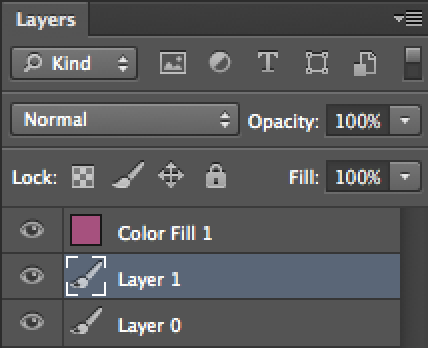
Well, what could be the problem? Something that we see all the time, but do not understand what the problem is there?
So, back to the layers! Suppose you opened a document in Photoshop that has one layer (pixel — for example, a photo). Let's quickly go over everything we can do with this layer (sorry for the abundance of English, so it’s more understandable):
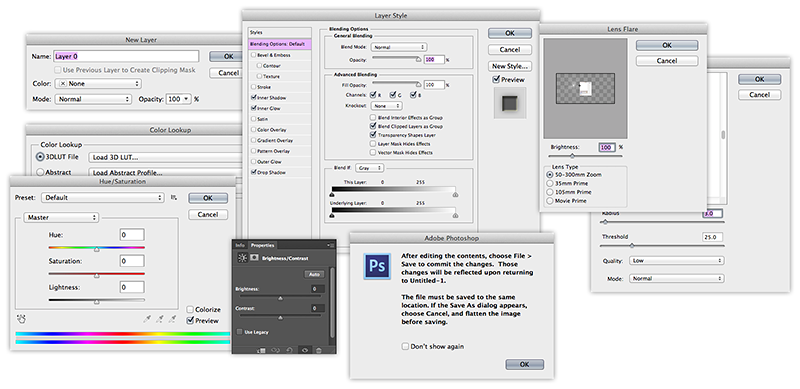
All these possibilities did not appear immediately in Photoshop. They were added and added year after year. Perhaps you are starting to guess what I'm getting at! All these things have different names, work differently, they have different interfaces. But as a result, they all have the same thing - they change the layer .
Here is another interesting point. Some of the functions listed above change the layer's contents directly - this is an irreversible change (I do not mean undo, but the concept in general). It is with such simple functions that the digital processing industry began - no one has yet been concerned with the reversibility of changes (and the hardware was not so powerful). Other functions make reversible changes (as if “overlapping” on top of a layer). This, for example, layer styles or masks.
In recent versions of Photoshop trying to solve the problem of irreversibility of processing, adding to the huge number of its functions a few more:
You know, I can proudly say that I have studied many of the most distant corners of Photoshop. But here it is - “To enable re-editable smart filters, the selected layer will be converted into a smart object.” - is that all? I could not accept such an approach and start working with it. Hey! This is a terrible hack, a crutch, and not a normal solution.
If you often travel and meet a lot of (beautiful) people, then you notice that despite the obvious difference in appearance and even behavior, the “essence” of people is the same. So with Photoshop! All his different functions in essence do the same thing — change the layer.
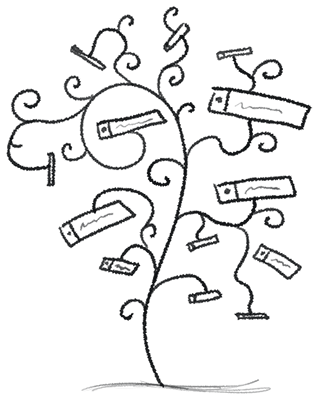
Below I will take two ideas from Photoshop and blind them with a completely new, fresh idea!
The first, of course - the layers . And the second - clipping mask .
Suppose you are working in an image processing program called “Onion” (well, because there are layers in the onion!).
You upload a photo from the camera, and you have a document with one layer (with pixel content). Suppose we want to add a bit of processing (let's say, contrast). Instead of applying a certain function, you add the “Contrast” layer as a “child layer” to the photo layer! So far it sounds like adjustment layers in Photoshop, and in part it is. But the idea is different - in general everything is layers!
And the whole point is that the layers can be "child" and "parent" (tree, like folders for files!). Of course, there are the usual top-level layers (technically, these are the layers-children of the whole document). Like the clipping mask in Photoshop, when you create a child layer, its action (content or processing) is applied only within the parent layer.
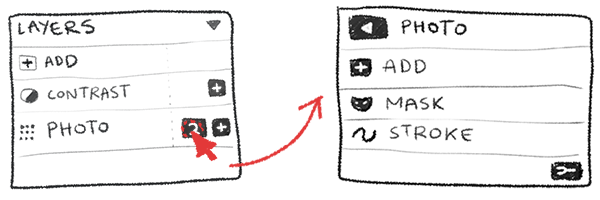
Perhaps for now this does not look very impressive, but if you strain your imagination and mentally “work” for some time (I tried it!), You will be shocked by the opening opportunities. Offhand -
A couple of sketches (do not forget - every action is a layer, you can hide it or delete it):

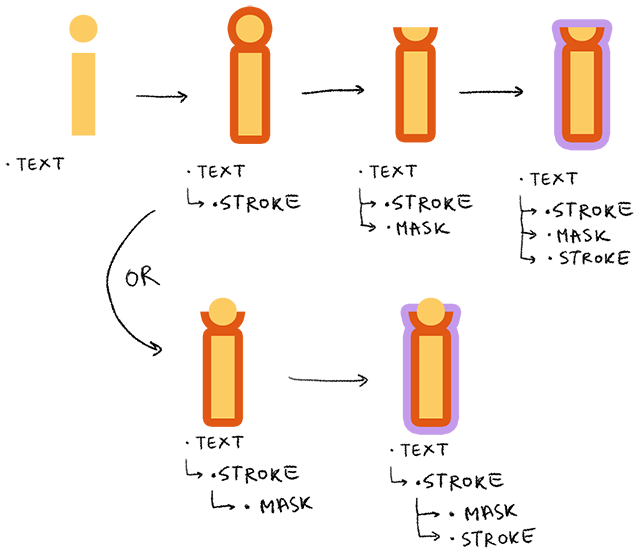
There is no end to possibilities. Of course, all this can be done right now in Photoshop (I know how). But it takes years of experience to understand hundreds of terms, and to train oneself to solve uninteresting puzzles - which set of tools to use and in what order in each particular case.
Why else I believe that this is very cool:
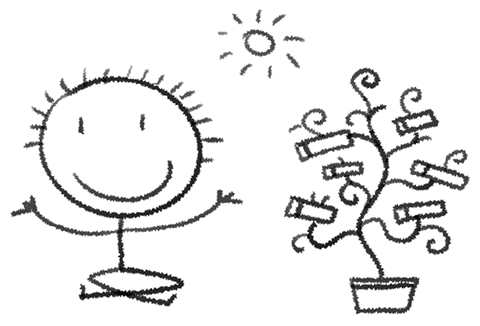
Thank you for being so patient and reading my article to the end. I really hope that she will inspire you and give you food for thought. Who knows, maybe one of you uses these ideas as a basis for developing a program that will become a new standard in the world of image processing!
Photoshop is the leader in its field. It can be called "standard" (which is rather good) or "monopolist" (which is rather bad). But the fact remains that if you work with any kind of digital graphics, you have to think in terms of Photoshop and follow the ideas of its creators.
Frankly, Photoshop is not the most complex computer program of the existing ones (since, frankly, digital images are not the most difficult part of computer science). However, it is still very complicated. There are several reasons. Firstly, in Photoshop there are many functions and, therefore, features. Secondly, he is old (he is very old, he ... well, you know :-) - almost my age! Such a long history of development means that the creators of Photoshop have come a long way, and they have not had the opportunity to revise the basic concepts or redo any things again. Compatibility and all that. And then, why repair something that did not break?
')

Images by about.com
However, tonight the idea came to me ... no, IDEA! And now she sits in my head, knocks and asks out, wants to be told, published and discussed. And what could be better than an interesting discussion!
So...
Problem no one notices
The first thing you will learn when starting to learn Photoshop is layers . The layer is the backbone of Photoshop. If you do not know how the layers work, I am afraid that this article will not interest you at all. Well, if very briefly - this is the "picture inside the picture." Photoshop stacks the layers one above the other, and you can work with the layer as with a separate image. Anyway, as a result of the work, there will be a “merged” image on the monitor (paper).

Well, what could be the problem? Something that we see all the time, but do not understand what the problem is there?
Lyrical digression. Do you know that you see your nose all the time, from morning till night? Even right now, reading these lines. It's just that your brain has learned to ignore it.
So, back to the layers! Suppose you opened a document in Photoshop that has one layer (pixel — for example, a photo). Let's quickly go over everything we can do with this layer (sorry for the abundance of English, so it’s more understandable):
- change its properties (name, color in the list of layers, lock, etc.)
- apply different adjustments to it (which are mainly found in the Image menu), for example, brightness, contrast, hue, saturation, black and white, invert, etc.
- we can also go to layer styles (sometimes called the Layer> Layer style> Blending options menu) and add things like drop shadow, stroke, outer glow, etc.
- apply a variety of filters - blur, distort, noise, etc.
- hide part of the layer with a mask .
- hide part of the layer using the clipping mask .
- change layer type (for example, rasterize type ).
- merge layers into groups .

All these possibilities did not appear immediately in Photoshop. They were added and added year after year. Perhaps you are starting to guess what I'm getting at! All these things have different names, work differently, they have different interfaces. But as a result, they all have the same thing - they change the layer .
Here is another interesting point. Some of the functions listed above change the layer's contents directly - this is an irreversible change (I do not mean undo, but the concept in general). It is with such simple functions that the digital processing industry began - no one has yet been concerned with the reversibility of changes (and the hardware was not so powerful). Other functions make reversible changes (as if “overlapping” on top of a layer). This, for example, layer styles or masks.
In recent versions of Photoshop trying to solve the problem of irreversibility of processing, adding to the huge number of its functions a few more:
- adjustment layers
- smart objects
- smart filters.
You know, I can proudly say that I have studied many of the most distant corners of Photoshop. But here it is - “To enable re-editable smart filters, the selected layer will be converted into a smart object.” - is that all? I could not accept such an approach and start working with it. Hey! This is a terrible hack, a crutch, and not a normal solution.
If you often travel and meet a lot of (beautiful) people, then you notice that despite the obvious difference in appearance and even behavior, the “essence” of people is the same. So with Photoshop! All his different functions in essence do the same thing — change the layer.
Eureka! Let any function be a layer! Grow a tree of layers!

Below I will take two ideas from Photoshop and blind them with a completely new, fresh idea!
The first, of course - the layers . And the second - clipping mask .
Suppose you are working in an image processing program called “Onion” (well, because there are layers in the onion!).
You upload a photo from the camera, and you have a document with one layer (with pixel content). Suppose we want to add a bit of processing (let's say, contrast). Instead of applying a certain function, you add the “Contrast” layer as a “child layer” to the photo layer! So far it sounds like adjustment layers in Photoshop, and in part it is. But the idea is different - in general everything is layers!
- content (pixels, vectors, text)
- processing (hue, saturation, levels, brightness)
- bevel, stroke, shadow
- noise, sharpen
- mask
And the whole point is that the layers can be "child" and "parent" (tree, like folders for files!). Of course, there are the usual top-level layers (technically, these are the layers-children of the whole document). Like the clipping mask in Photoshop, when you create a child layer, its action (content or processing) is applied only within the parent layer.

Perhaps for now this does not look very impressive, but if you strain your imagination and mentally “work” for some time (I tried it!), You will be shocked by the opening opportunities. Offhand -
- there is a layer with a photo, to it we make a child layer sharpen , and to it a child layer a mask , and we can apply a sharpen only to a part of the photo.
- there is a vector layer, we add a child layer stroke , and to it a pixel layer child, and we can only draw with a brush inside the stroke lines!
- there is a layer, we add a layer child mask , change the opacity of this layer - the mask becomes translucent.
- long dreamed of several strokes to one layer? Easy! Just add 2 consecutive layer child strokes. This also applies to any other processing layers.
- You can group the layers and work with the group as with a layer — that is, add any child layers!
- Of course, any layer can be hidden - which is hidden in Photoshop in: show / hide layer, enable / disable layer mask, show / hide layer styles, etc.
- Of course, any layer sets can be duplicated or copied to other parent layers. No more paste styles!
- and of course, all the child layers can be “applied” (“pasted”, merge) to the parent layer.
A couple of sketches (do not forget - every action is a layer, you can hide it or delete it):


There is no end to possibilities. Of course, all this can be done right now in Photoshop (I know how). But it takes years of experience to understand hundreds of terms, and to train oneself to solve uninteresting puzzles - which set of tools to use and in what order in each particular case.
Why else I believe that this is very cool:
- The concept is very simple both for understanding and for programming. Once you understand the concept of the layer tree, you can do anything. From the point of view of the developer, it is no more difficult to make such an editor than the game Minesweeper (well, maybe a little harder). Actually, the interface is one - the layers. Plugins? Let's call them layers!
- This is an ideal model of reversible processing. The source is always securely covered.
- This is not DVORAK. All already have a rough idea of the layers (thanks, Photoshop!). There will be no disease retraining, like switching from a QWERTY keyboard to DVORAK. Dz-zen!

Time for coffee
Thank you for being so patient and reading my article to the end. I really hope that she will inspire you and give you food for thought. Who knows, maybe one of you uses these ideas as a basis for developing a program that will become a new standard in the world of image processing!
Source: https://habr.com/ru/post/172403/
All Articles